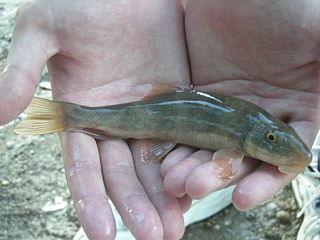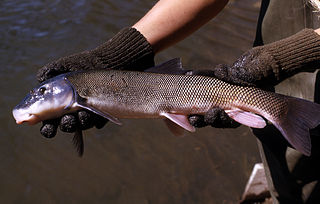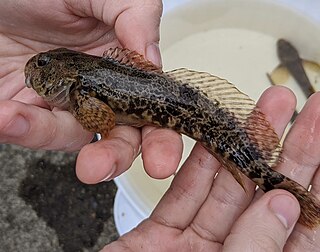
The longnose sucker is a species of cypriniform freshwater fish in the family Catostomidae. It is native to North America from the northern United States to the top of the continent. It is also found in Russia in rivers of eastern Siberia, and thus one of only two species of sucker native to Asia.

Catostomus is a genus of fish belonging to the family Catostomidae, commonly known as suckers. Most members of the genus are native to North America, but C. catostomus is also found in Russia. Fish from different species of the genus are known to readily hybridize with each other.

The mountain sucker is a sucker found throughout western North America, on both sides of the Rocky Mountains, including the upper Missouri River, Columbia River, Sacramento River, and Colorado River. It is not limited to higher altitudes but is known from locations as high as 2,800 m (9,200 ft). It is a slender, streamlined fish typically under 20 cm (8 in) in length. It is generally olive green or brown above, with pale underparts, and breeding males have a lateral red-orange band and fins suffused with the same color. It is mainly herbivorous, feeding on algae and diatoms. Breeding takes place in late spring and early summer in gravelly riffles in small streams.

The Santa Ana sucker is a freshwater ray-finned fish, endemic to California. It is closely related to the mountain sucker and has dark grey upper parts and silvery underparts. It grows to a maximum length of 25 cm (10 in), but most adults are much smaller than this. It feeds on algae, diatoms and detritus on the floor of shallow streams with sand, gravel or cobble bottoms. It is found in only a few streams in southern California, and many of these in the Greater Los Angeles metropolitan area have been restricted to concrete channels. Because of its small area of occupancy and vulnerability, the International Union for Conservation of Nature has rated this fish as "endangered".

The Yaqui sucker is a species of ray-finned fish in the family Catostomidae. It is found the Aridoamerica region of northern Mexico and south-western United States. Catostomus bernardini or Yaqui sucker belongs to the family Catostomidae. The Yaqui sucker is related to the Sonora sucker and could possibly be a subspecies of the Gila sucker.

The Klamath largescale sucker is a species of ray-finned fish in the family Catostomidae.

The largescale sucker is a species of sucker, a type of freshwater fish, found in western North America.

The Catostomidae are the suckers of the order Cypriniformes, with about 78 species in this family of freshwater fishes. The Catostomidae are almost exclusively native to North America. The only exceptions are Catostomus catostomus, found in both North America and Russia, and Myxocyprinus asiaticus found only in China. In the Ozarks they are a common food fish and a festival is held each year to celebrate them. Ictiobus cyprinellus can reach an age up to 112 years, making it the oldest known freshwater teleost.

The bluehead sucker is endemic to the intermountain Western US. A total of 23 members of the genus Catostomus has been found in North America. C. discobolus and C. yarrowi are two sister species that have very similar Arizona habitats.

Catostomus latipinnis is a North American fish identified by its enlarged lower lips. It belongs to the genus Catostomus, commonly known as suckers. Historically, the flannelmouth sucker ranged in the Colorado River Basin, including parts of Wyoming, Utah, Colorado, New Mexico, Nevada, California, and Arizona; however, this species has been entirely extirpated from the Gila River Basin in Arizona.
The bridgelip sucker is a fish in the family Catostomidae that occupies the Columbia River system. Like all sucker fish, they live only in fresh water. Bridgelip suckers have a tendency to live in deeper waters during the day and move into shallower water around evening time. As adults they eat periphyton. Adolescents, however, eat aquatic hatchlings and zooplankton. Adult bridgelip sucker range in size from 5 inches to 17 inches. They spawn around May, when the water temperature is between 8-13 C, and lay somewhere around 9,955 and 21,040 eggs. Inside of the Columbia River system, the bridgelip sucker shares much of its territory another similar looking sucker, the largescale sucker.

The Owens sucker is a fish in the family Catostomidae which is endemic to California.

Mylopharadon conocephalus, known as the hardhead, is a freshwater ray-finned fish from the family Cyprinidae, the carps and minnows, which is endemic to California. It is the sole member of the monotypic genus Mylopharadon.

The Modoc sucker is a rare species of freshwater fish native to northern California and southern Oregon. It grows to a length of about 7 in (18 cm) and becomes sexually mature at 4 in (10 cm). It feeds on algae, small invertebrates and detritus, and hides under stones, detritus and overhanging vegetation. It is found in only a few streams and is listed as an endangered species in California and the United States. Conservation measures have been put in place such as fencing the streams in which it lives from livestock. It was previously rated as "endangered" by the International Union for Conservation of Nature, but this rating has now been changed to "near threatened".

The prickly sculpin is a species of ray-finned fish belonging to the family Cottidae, the typical sculpins. It is native to the river drainages of the Pacific Slope of North America from Seward, Alaska south to the Ventura River of Southern California. It extends east of the Continental Divide in the Peace River of British Columbia. It has also been introduced to several reservoirs in Southern California.

The desert sucker or Gila Mountain sucker, is a freshwater species of ray-finned fish in the sucker family, endemic to the Great Basin and the Colorado River Basin in the United States. It inhabits rapids and fast-flowing streams with gravelly bottoms. It is a bi-colored fish with the upper parts olive brown to dark green, and the underparts silvery-tan or yellowish. The head is cylindrical, tapering to a thick-lipped mouth on the underside. This fish can grow to 31 in (79 cm) in Arizona but is generally only about half this size elsewhere. There are three subspecies, found in different river basins, and some authorities allot this species its own genus Pantosteus.

The white sucker is a species of freshwater cypriniform fish inhabiting the upper Midwest and Northeast in North America, but it is also found as far south as Georgia and as far west as New Mexico. The fish is commonly known as a "sucker" due to its fleshy, papillose lips that suck up organic matter and aufwuchs from the bottom of rivers and streams.

The Tahoe sucker is a freshwater Cypriniform fish inhabiting the Great Basin region of the Western United States.
The Tule River is a 5.7-mile-long (9.2 km) river tributary to the Fall River. The river is a complex of spring-fed lakes and waterways originating in Ahjumawi Lava Springs State Park in north-eastern Shasta County in northern California. From the Fall River, its waters continue to the Pit River and then the Sacramento River to the Pacific Ocean.

The Klamath smallscale sucker(Catostomus rimiculus), also known as the Jenny Creek sucker, is a species of ray-finned fish in the family Catostomidae. It is a freshwater fish that primarily inhabits the Trinity and Klamath River watersheds, as well as the overall region of the Klamath Basin in general. Within the Klamath Basin, they inhabit the area along with three other sucker fish: the Lost River sucker, shortnose sucker, and the Klamath largescale sucker. These fish can vary in length from 35 cm to 50 cm, and usually have a lifespan of around 9-15 years. They often form mixed schools with speckled dace, sculpins, and juvenile steelhead.



















